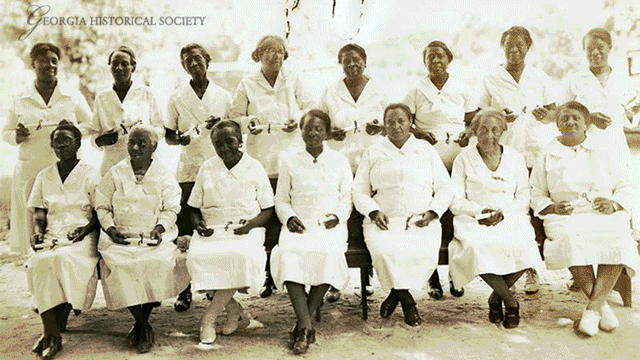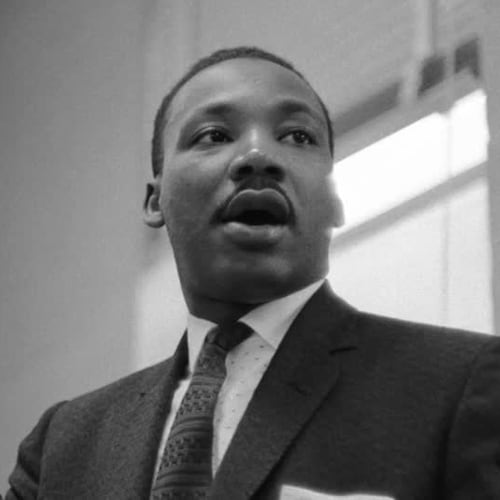Sarahn Henderson has been “catching babies” for more than 40 years.
It all started after she enlisted the support of a midwife to help her deliver her first child at home. The birth worker, sensing Henderson had the right touch, invited her to help during another delivery and soon offered to train her.
Since then, Mama Sarahn, as Henderson is known to her peers, clients and mentees, has helped bring more than 1,000 babies into the world — not in hospital beds, where more than 98% of American children were born in 2017, but in homes across metro Atlanta.
A key mission of Henderson’s practice, Birth in the Tradition, is to honor many of the birthing customs brought to America with the first African slave ships some 400 years ago. Those practices were handed down from mothers to daughters who toiled on Southern plantations and were later locked out of the medical establishment under segregation.
”They were pillars of their community,” said Henderson, who started traveling to South Georgia in the early 1980s to interview so-called “granny midwives” — whom she’s rebranded “grand midwives” — and document their stories before they vanish. “The women counted on them just like they counted on a schoolteacher, just like they counted on a preacher.”
Credit: Ben Gray
Credit: Ben Gray
Increasingly stiff regulations, cultural shifts and the advent of the modern health care system eventually brought midwives to the brink of extinction, including the Black practitioners who devoted their lives to serving their friends and neighbors. But the tides have begun to change for midwives in recent years.
The natural care movement is prompting some pregnant women to eschew hospitals and instead look at home births and birthing centers. The same goes for mothers-to-be craving a more personal relationship with their birth attendant or a low-intervention delivery.
COVID has accelerated the shift, as has a growing body of research suggesting Black midwives could help cut down on Georgia’s stubbornly high maternal mortality rate.
Problem is, many midwives technically practice illegally in Georgia. The state licenses a certain class of midwives who have nursing degrees, but it no longer recognizes so-called direct-entry midwives like Henderson, who trained for years as an apprentice but does not have a medical background.
The state has largely left those direct-entry midwives alone and even offers a way for women who give birth at home to obtain birth certificates. Most direct-entry midwives advertise their services publicly, and some are certified by accredited midwifery organizations that are recognized by other states.
Credit: Jenni Girtman
Credit: Jenni Girtman
But they also work under a constant cloud of uncertainty. In New York, a woman now faces 95 felony counts of practicing midwifery without a license and one count of criminally negligent homicide tied to the death of a baby she delivered in 2018.
Two bills introduced in the Georgia Legislature last year sought to license direct-entry midwives, but they stalled after laying bare the deep divisions within the profession along racial and educational lines. Stakeholders believe a compromise is in sight, but they face fierce pushback from powerful doctors groups that have long argued midwives working outside of hospitals lack accountability and compromise safety for both mothers and babies.
Community caretakers
Midwives were an integral part of life in the South long before the country was founded.
Certain women were captured in West African villages for their knowledge of birthing positions and herbs moms-to-be needed to eat to prepare their bodies for delivery. Those skills were utilized on American plantations, where enslaved Black midwives delivered the babies of their white masters, as well as other slaves.
“Birthing was about breeding,” said Jamarah Amani, co-founder of the National Black Midwives Alliance, a professional association that’s currently shooting a documentary about Black midwives in the South. “There was a significant investment from the slaveowners to have healthy births and babies so they could keep their property alive.”
Credit: Library of Congress
Credit: Library of Congress
The traditions continued in tightknit Black communities even after slavery ended.
Midwives’ work began months before a woman gave birth and continued postpartum. They would coach moms-to-be on how to prepare for their new arrivals, monitor their health and sometimes act as spiritual counselors. When delivery was imminent, the birth workers would walk miles to a pregnant woman’s home and sometimes stay for days, soothing their clients and caring for their other children until the baby came.
“They were really the caretakers in their communities when Black folks didn’t have access to doctors and preferred to go to midwives because of the level of trust,” said Amani, who’s also a licensed midwife in Florida.
For their efforts, the women were paid little, sometimes a few dollars per delivery. Others weren’t paid at all — or were given a chicken, wild rabbit or vegetables for their services.
Things started to change in the 1910s and 1920s. White progressive reformers saw many of the practices used by midwives as “unsanitary and superstitious,” according to a 2010 paper published in the American Journal of Public Health. They published statistics to argue that midwives were to blame for high infant and maternal mortality rates.
Doctors groups pushed to eliminate traditional healers in favor of standardized physician care, which they promoted as more hygienic. More and more women — especially well-off white women — opted for hospital births.
At the turn of the 20th century, about half of U.S. births were attended by midwives. By 1935, that number had dropped to 12.5% of births.
Credit: Library of Congress
Credit: Library of Congress
State steps in
Black midwives held on despite those seismic changes, especially those practicing in more rural portions of the South. Yet as the years wore on, states ratcheted up regulations surrounding their work.
By the outset of World War II, Georgia required midwives to seek certification from the state board of health and attend regular training classes. Taught by white health officials, those classes focused on promoting cleanliness and teaching new techniques like applying silver nitrate drops to prevent gonococcal blindness.
Those state training classes were depicted in a 1952 instructional film well-known among midwives even today. Produced by the Georgia Department of Health, “All My Babies” follows Mary Coley, a Black midwife in Dougherty County who’s shown sanitizing her equipment, loading up her state-issued black medical satchel and accompanying patients to the local health clinic.
The film sheds light on life in rural South Georgia in the era of Jim Crow: the tightknit community bonds, the grinding poverty and the patronizing relationship between the white medical establishment and the Black midwives who filled the gaps left by segregation.
In one scene, a white health officer scolds a group of a dozen Black midwives — all wearing starched white aprons and caps — for a baby who died during a recent home birth delivery.
“My examination showed that his cord got infected, and you all know what that means,” the health officer tells the women. “Something wasn’t clean.”
Those meetings at the health department often included bag inspections, enforced by threat of a $1,000 fine or 12 months in a chain gang. Some midwives would keep two satchels, according to Henderson’s research. One had all the state-approved tools like blunt scissors, boric acid powder and gauze dressing that would be brought to the inspections. A second, secret bag would include contraband items like roots and herbs and “other things that might aid in the mother’s birthing experience.”
Credit: Ben Gray
Credit: Ben Gray
Literacy requirements were also imposed, according to Henderson, as well as rules that midwives deliver at least 10 babies a year to maintain their licenses. Eventually, the state stopped certifying direct-entry midwives entirely, pushing many grand midwives into an early retirement.
In Mississippi, registered midwives shrank from 5,000 in 1921 to just 20 in 1985. Nationally, only about 1% of births were being attended by midwives by the early 1970s.
“It really was a systematic eradication,” Amani said.
Credit: Georgia Historical Society
Credit: Georgia Historical Society
Searching for empathy
Beginning in the 1970s, a new generation of American midwives emerged. Many were white and served a more crunchy clientele interested in things like natural foods, medicinal herbs and breastfeeding. (For her part, Henderson first learned about midwifery while working at the Golden Pyramid, a health foods store in southwest Atlanta, in the late 1970s.)
Black practitioners today still number few and far between in Georgia — nationally, they constitute about 2% of practicing midwives — but they’re being sought out by a growing number of women of color.
Recently, one of those clients was Rimani Kelsey-Rogers. The Atlantan was searching for a midwife who could oversee the birth of her second child in a home setting. She wanted someone with a personal touch who would respect her birth plan while balancing safety concerns.
“Birth is a very personal and intimate and beautiful and memorable experience,” said Kelsey-Rogers, herself a doctor of family medicine. “You want that personal aspect of it — not someone just telling you ‘lay flat, change into this hospital gown.’”
Credit: thebirthstorycollective.com
Credit: thebirthstorycollective.com
Also important to Kelsey-Rogers was finding a midwife of color, which is what eventually led her to Henderson.
“To have someone who looks like you ... There’s a different level of empathy, of understanding,” said Kelsey-Rogers, who delivered her daughter Sadia, which means blessed princess, in December.
Studies suggest Black providers, and particularly midwives, could make a big difference in lowering maternal mortality rates, which the state for years has struggled to contain. Black mothers in Georgia are three to four times more likely to die in the first year after giving birth than their white counterparts, regardless of education or income.
Deep-rooted social inequalities are mainly to blame, from lack of access to healthy food to doctors who systematically play down their pain. Early, attentive and culturally sensitive care from providers is believed to make a major difference.
Christine Taylor, owner of the midwifery practice Birth by Grace in Fayette County, said she often hears an “audible sigh” when she meets with new Black patients “because they automatically feel safe and comfortable and they know they can relate to this person who looks like them and understands them better.”
Credit: Jenni Girtman
Credit: Jenni Girtman
“When women are seeking care because they’re afraid to go into these big (medical) establishments where they know they’re just a number,” said Taylor, whose clients are 98% women of color. “They feel ignored and mistreated.”
COVID-19 is driving even more patients to practices like Taylor’s. With hospitals packed and doulas and family members locked out of delivery rooms, some women are looking for options where they can have their support system with them.
Legislative fighting
Taylor, who grew up in Chicago, has a different background from Henderson and Amani. She’s a certified nurse-midwife, with a bachelor’s degree in nursing and a master’s in midwifery.
The state of Georgia licenses midwives like Taylor through the Board of Nursing. (There were about 550 of them in the state in 2018, according to the Georgia affiliate of the American College of Nurse-Midwives.)
But unlike roughly three dozen other states, Georgia does not license any direct-entry midwives.
Credit: Ben Gray
Credit: Ben Gray
Whether and how to do so has been a question before the state Legislature for years, one that took on more urgency in 2019 after a baby in Dearing, Georgia, died while being delivered by an unlicensed midwife. That same year, a separate well-known but unlicensed midwife was issued a cease-and-desist order and threatened with fines by the Georgia Board of Nursing for calling herself a midwife. (The woman, Debbie Pulley, was a top official at the North American Registry of Midwives, an accredited certification group, and was non-practicing. Pulley sued the nursing board.)
One bill introduced in the Georgia House that year would have licensed midwives certified by the Registry, which requires applicants to complete an apprenticeship or midwifery training program and pass a test.
That idea was fought by some Black direct-entry midwives who learned their crafts in a less formal way. Many found the Registry and other large midwifery organizations unwelcoming and their tests biased. They argued that linking licensure to that type of certification would be exclusionary to midwives of color with limited finances.
That group converged around a separate measure introduced by state Sen. Lester Jackson, D-Savannah, last year that would have licensed a broader cross section of direct-entry midwives.
“We want to make sure that people who practice midwifery can practice their craft and do it without fear of being arrested for breaking any laws,” said Jackson, whose grandmother and great-grandmother practiced midwifery in Wheeler County.
Jackson said a compromise bill is in the works that would license many types of direct-entry midwives, not just those certified by the Registry. He hopes the Legislature’s passage of a maternal mortality bill last year will increase demand for his midwifery proposal.
Credit: Alyssa Pointer
Credit: Alyssa Pointer
Pushback from doctors
By expanding midwife licensure in Georgia, Jackson’s measure could also open the door to Medicaid, the federal-state health insurance program for the poor, reimbursing midwives for home births. That would be a boon for the birth workers, some of of whom struggle to make ends meet.
Insurance coverage for home births, meanwhile, can be spotty.
The Legislature’s licensure efforts, however, have attracted opponents in the influential Georgia OBGYN Society and Medical Association of Georgia. The latter believes that prenatal services not delivered by doctors or certified nurse-midwives should be prohibited. (Certified nurse-midwives almost always work in hospitals and clinics under the tutelage of doctors. Their trade groups have long pushed for more autonomy.)
There’s long been simmering distrust between doctors and midwives. Midwives argue doctors often intervene unnecessarily during birth, all too often approving invasive procedures like cesarean sections. And they point to studies that conclude that planned home births for low-risk women result in safe outcomes and fewer interventions than in hospitals.
Many doctors groups, meanwhile, say direct-entry midwives lack the necessary education and have no uniform standards of practice, leading to little accountability when things go wrong, especially if they delay transferring patients to hospitals during emergencies.
The American College of Obstetricians and Gynecologists’ website says home birth “is associated with a more than twofold increased risk of perinatal death and a threefold increased risk of neonatal seizures or serious neurologic dysfunction” and that unplanned home births are particularly unsafe.
“Keeping in mind that any health care professional’s education and experience are important factors, one of (the Medical Association of Georgia’s) ongoing priorities is ensuring that patients have access to safe, high quality, and evidence-based care,” said Bethany Sherrer, the group’s legal counsel.
Despite the divisions both inside and outside the industry, many Black midwives believe the work is worthwhile, especially if it means carrying on traditions that have been passed down for centuries.
“It is really a deep, ancestral, spiritual calling,” said the National Black Midwives Alliance’s Amani. “A deep, deep calling that we need to be there for these babies that are coming into the world.”
Credit: Georgia Historical Society
Credit: Georgia Historical Society
Photos from the Georgia Historical Society are used with permission.
TYPES OF BIRTH WORKERS
Midwives are different from OB-GYNs and doulas, all of which have different levels of education and philosophies when it comes to birth:
Obstetrician-gynecologists (OB-GYNs) are doctors with years of training, in medical school and then in a residency. They can perform medical procedures and surgeries like cesarean sections in case of an emergency.
Midwives can deliver low-risk babies in hospitals, clinics, birthing centers and homes, depending on the state. They cannot perform surgery but can sometimes prescribe medications. They tend to advocate for low medical intervention and have a more hands-on relationship with their patients. What they can and can’t do varies by state.
Doulas play more of a supportive role during births but can’t deliver babies. They coach women in labor on breathing patterns, birthing positions and how to relax.
Even within the midwife profession, there are several different distinctions. They largely fall into two buckets:
Certified nurse-midwives have nursing degrees and then complete graduate studies in midwifery and pass a national certification exam. They mostly work in hospitals and clinics under the tutelage of doctors. They are the only type of midwife currently licensed to practice in the state of Georgia.
Direct-entry midwives earn their skills through different types of training: by going to school, completing apprenticeships or self-studies. They often deliver babies at home or work in birthing centers. Some seek certifications from national midwifery organizations, which generally require achieving a certain standard of knowledge and passing a test. About three dozen states license at least some types of direct-entry midwives. Georgia hasn’t for decades.
BLACK HISTORY MONTH
Throughout February, we’ll spotlight different African American pioneers ― through new stories and our archive collection ― in our Living and Metro sections Monday through Sunday. Go to AJC.com/black-history-month for more subscriber exclusives on people, places and organizations that have changed the world, and to see videos on the African American pioneers featured here each day.
About the Author
The Latest
Featured












